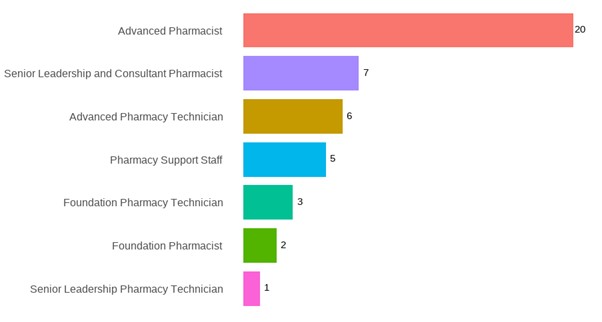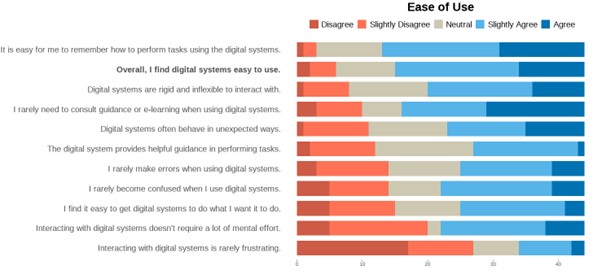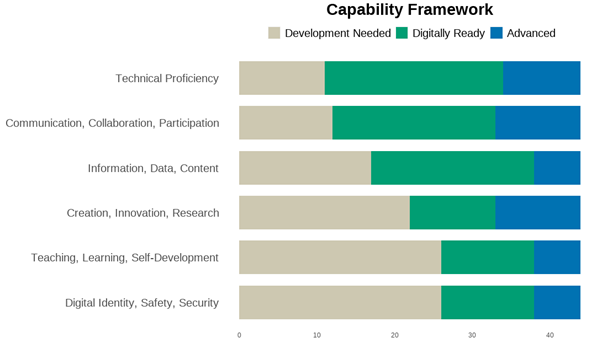Digital literacy and ease of use of digital systems survey
The importance of focusing on digital literacy and the ease of use of digital systems.
Whilst working on the implementation and creation of a diverse range of digital projects throughout the years, as well as from colleague feedback, I have found that one of the most common and impactful barriers universal to them all is digital literacy. So, when generating my Topol Digital Fellowship proposal on the digital transformation of an aseptic unit, I wanted to include it as a key priority, to make sure everyone could enjoy the benefits, and that no one felt left behind.
Introduction
If you browse through recent NHS reviews, from Wachter to Topol, long-term planning to people planning, and right up to the recent artificial intelligence (AI) roadmap, you will find that digital literacy makes a regular appearance. Essential to looking good, it is also crucial to the achievement of many key targets and agendas within the NHS.
This year Health Education England (HEE) published digital capabilities for the pharmacy workforce, a paper that applies their capability framework to pharmacy roles, and pairs the skill levels with available training packages. I wanted to gain a better understanding of the current digital perceptions and capabilities of the pharmacy workforce within my local site, so I created and shared a survey I hoped would do just that.
Survey
The survey was divided into two main areas; the first was to capture general attitudes towards digital systems, with questions based on ease of use and usefulness, before the second focussed on the capability domains created by Health Education England (HEE). The survey was promoted by posters, e-mail, and communication by managers. Participants were given both offline and online methods to complete the survey, as well as a chance to win a coffee shop gift card.
Participation
44 members of staff participated in the survey, around 17% of our local department.

The most common role participating in the survey was advanced pharmacist, but at least 1 participant from each of the roles listed within the competency framework completed the survey.
Ease of use and usefulness
See my website to access an interactive summary of ease of use and usefulness results, allowing you to filter results by role.
The overall theme from this section was that the majority perceive digital systems as being useful, but not easy to use. There were notable exceptions however, as for usefulness the most disagreement was with the statement 'digital systems meet all of my needs or requirements'. For ease of use, it was the statement 'interacting with digital systems is rarely frustrating' that had the most disagreement. The ranking of further statements also provided a good insight on areas to address and those we can only assist with.


Capability framework
Each domain within the capability framework has 4 levels of competency, and each role has a recommended competency level for digital readiness. Participants selected which level description they aligned most closely with, allowing for comparison against the framework.
The domains 'teaching, learning and self-development' and 'digital identity, safety, security' were the areas requiring the most development, which in my opinion are 2 of the most important domains, identifying a real urgency to address these issues.

Open feedback
The final question of the survey was a textbox, asking what the main challenge was to improving digital skills and knowledge. The most common issue raised by 40% of participants was not having protected time to attend initial training or to familiarise themselves with new updates or features. Participants also explained that most learning occurs on the job, either from an e-mail or colleagues who were also self-taught, and that practical demonstrations from advanced users would be preferred.
The second most common challenge was frustration around the number of systems routinely required, the subsequent number of logins, time spent logging in, lack of integration, and different ways to interact within each system prevents getting to know a single system in detail. Multiple participants stated that sometimes they feel the benefits provided are outweighed by the number of work arounds, duplication, and gaps in processes resulting from poor integration.
Other comments were around concerns that the questions they had would be considered too basic so were not seeking assistance, and 2 participants commented that when they started their career digital systems were not in use and that they have felt unsupported through the ongoing digital changes.

Summary
The Topol Review itself highlighted that whilst release of time away from service provision is critical to the success of achieving widespread digital literacy, 4 other challenges also need to be addressed.
- Reducing significant variance in current levels of digital literacy.
- Raising workforce awareness of digital capabilities.
- Providing equitable access to support, learning and training with special efforts to engage and support the digitally unengaged or unconvinced.
- Developing appropriate workforce skills and attitudes to empower patients and citizens to enhance their health and wellbeing through digital healthcare technologies.
As a direct consequence of reviewing the survey results we immediately set up fortnightly drop-in sessions which staff can request to be released from service provision to attend. These drop-in sessions are for any questions to be asked, no matter how big or small, and for any digital system.
The next stage of our response is to allocate each capability framework role a member of our pharmacy informatics team. The team member will then engage with that role through attendance at communications meetings to promote digital capabilities and receive wider feedback regarding digital systems directly. This will reduce barriers between staff and digital development by making our team accessible and approachable. The improved relationship will also be beneficial for future digital projects beyond literacy, to directly capture honest stakeholder views, and proactively identify issues earlier.
Page last reviewed: 24 April 2023
Next review due: 24 April 2024